To perform well as an athlete, or even train safely in the gym, both mobility and flexibility are essential staples of fitness.
Mobility vs. Flexibility
The terms “mobility” and “flexibility” are thrown around a lot in the fitness world, but do we really know what they mean?
Mobility: The amount of functional movement one has around an active joint while in motion. For example, how well can a golfer move his or her hips through a golf swing?
Flexibility: The total range of motion around a joint in a passive situation. For example, while being stretched by the athletic trainer, how far can the leg move into flexion before the hamstrings stop the range of motion?
Good flexibility doesn’t always lead to good mobility, and vice versa, but the two do benefit each other.
Joint mobility exercises make for a great warm-up to lead to a more effective and safe workout, while flexibility exercises are best saved for the end of the workout when the body is nice and warm and ready to be stretched passively.
The TRX Suspension Trainer is a great way to improve mobility and flexibility:
- The TRX allows you to unload bodyweight while doing specific movements. By unloading some bodyweight, it is possible to safely move through a greater range of motion.
- The TRX can add resistance and leverage to a particular stretch, helping safely pull the body to a range of motion that might not otherwise be achievable.
- Stretches on the TRX can flow seamlessly from one to the next, mimicking how the body moves in daily life.
- The TRX offers the ability to work with and against the straps while moving into various stretches, reinforcing proper body mechanics and posture.
- And finally, the TRX makes it possible to manipulate the difficulty and intensity of every movement, making it safe, appropriate and sufficiently challenging for all levels of users.
Mobility Exercises
Complete 10 reps of each exercise in a controlled fashion before moving onto the next exercise.
TRX Squats
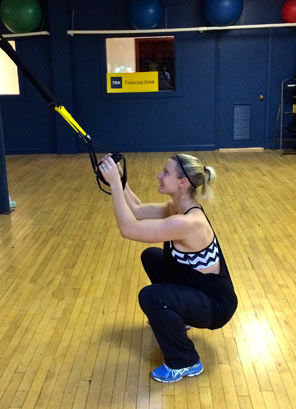
Why: Many people are fully capable of completing a squat without assistance, or even with a heavy load, but how well are they moving? By unloading weight with the TRX Suspension Trainer, it is possible to move through a larger range of motion and perfect squat form. This movement also improves mobility in the ankles, knees and hips before activity.
How: With the straps at mid-length, begin by standing facing the anchor point. Drop the hips straight down to the floor into a pain-free squat. Ensure the spine and shin angle are parallel, and then push (and pull) back to the starting position.
TRX Wall Slides
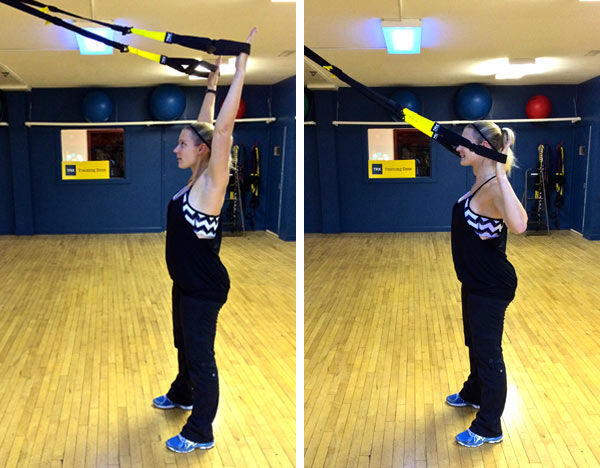
Why: Activating the posterior chain and bracing the core during this exercise allows for greater range of motion in the shoulder joint. This is also a great exercise for core stability and parascapluar strength.
How: With the straps at mid-length, begin by standing facing the anchor point. Place the backs of the hands in the foot cradles, and bring the arms into a goal post formation. While maintaining constant backward tension on the foot cradles, press the hands up above the head, not allowing the back to arch. Return to the starting position without releasing tension in the straps.
TRX Golf Rotation
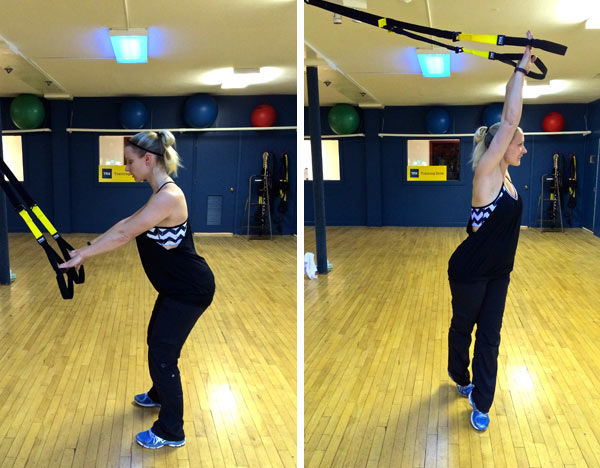
Why: Targeting mobility in the hips, thoracic spine and shoulders, this movement helps to safely incorporate rotation into workouts and sports.
How: With the straps at mid-length, begin by standing facing the anchor point. Step back so that the hands are about belly-button height. Keeping the hands fairly close together, maintain pressure on the TRX while rotating 180 degrees in one direction, stretching toward the ceiling and opening through the hips. Return and repeat on the other side. If full rotation cannot be achieved without causing lower-back extension, limit the range of motion until adequate mobility is achieved.
Flexibility Exercises
Hold each stretch for about 30 seconds, or four to six deep breaths.
TRX Seated Figure-4 Stretch
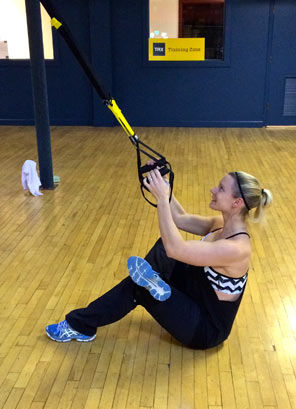
Why: Regular stretching of the piriformis can help alleviate sciatica pain and prevent knee pain and symptoms of plantar fasciitis. The TRX allows for a deeper figure-4 stretch without compromising posture.
How: With the straps at mid-length, begin by sitting about 2 to 3 feet away from the anchor point. Keep the left leg straight and cross the right ankle over the left knee. Bend the left knee until a stretch is felt in the right hip. Gently use the straps to lift the chest up toward the anchor point, engaging behind the shoulder blades.
TRX Long Torso Twist Stretch
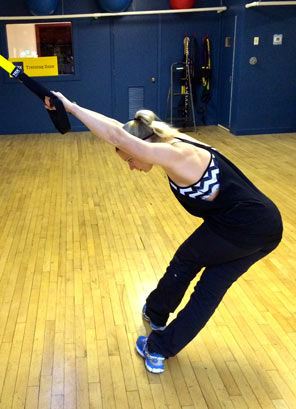
Why: This all-in-one stretch will help develop flexibility in the lats, thoracic spine and hips, while helping alleviate IT band tightness.
How: With the straps at mid-length, begin by standing facing the anchor point. Walk back until the hands are at about chest height. Cross the left leg over the right so that both feet are pointing to the right. Keep the chest square with the anchor point (creating a “twist” in the waist) and fold in half; press the right hip toward the floor.
TRX Chest Stretch
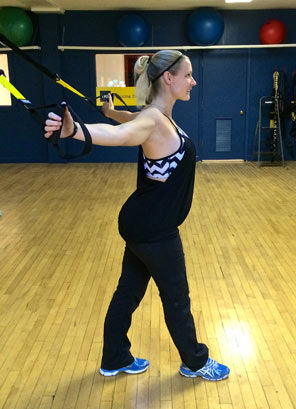
Why: With the amount of time most people spend sitting slumped over computers, the muscles in and surrounding the chest become shortened and overtight, leading to postural and shoulder issues. By opening the chest up with the TRX , many different angles and movements can be achieved.
How: With the straps at mid-length, stand facing away from the anchor point. Walk forward until the arms form a “T”. Without leaning, step one foot forward while keeping the thumbs turned up toward the ceiling.
Added bonus: Torso and shoulder mobility can be improved by adding arm and waist movement with this stretch.
For more detail and insight on TRX for mobility, stability, and flexibility, check out TRX Training’s new Level 2 TRX TEAM educational course, providing education on a Yoga Inspired TRX workout.




 by
by 





 by
by